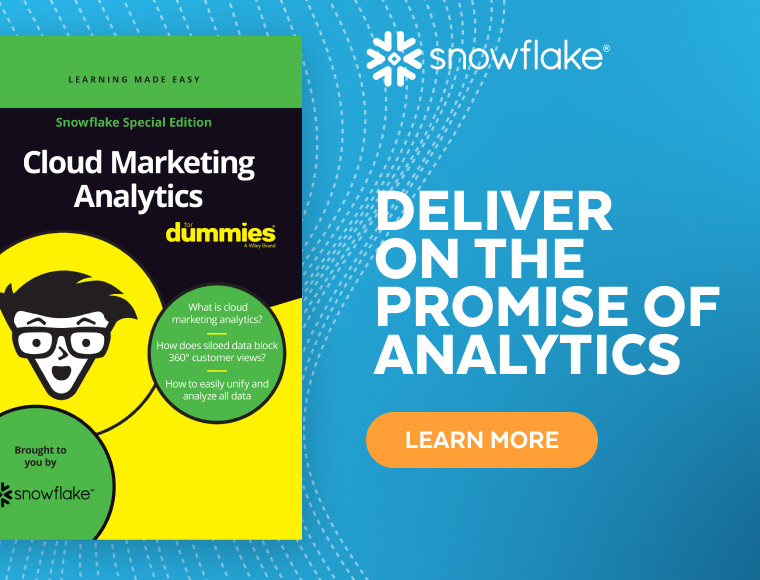Effective marketing is based on data, not guesswork. Successful marketers are using the customer data they have available to inform marketing decisions and improve performance. Let’s look at why a 360-degree view of customer data is advantageous to today’s marketers and what you need to create a customer 360.
What Do We Mean by Customer Data?
Customer data is a broad category that can include customer demographics, purchase information, website visitation, app engagements, and more.
In a B2B context, for example, a prospect might click on a social media post that takes them to your company website. There, the prospect might fill a form to download a piece of content, sharing their name and email address. This prospect might then view a pricing page and an industry-specific use case page on your website and then fill out another form with purchase intent information while registering for a demo. Once becoming a customer, this individual might contact customer service for support. And then they might leave a review of their experience. All of the data created via these actions is customer data.
Types of Customer Data
Marketers can benefit from several types of data: personal, behavioral, engagement, and attitudinal. These data types often function together in customer interactions and transactions.
Personal Data
Personal data includes three types of data: personally identifiable, linkable, and non-personally identifiable. Personally identifiable data is information that is connected with an individual identity, such as name, email address, mailing address, phone number, login details, and payment details. Linkable data is information that isn’t currently tied to an individual but could be when combined with other data such as ZIP code, gender, age group, job category, career level, and so on. Non-personally identifiable information, such as IP address and device ID, is considered anonymous.
Behavioral Data
Behavioral data is information related to the customer’s buying journey. It includes transactional data such as purchase history, subscriptions, and cart abandonment, as well as information on product usage data such as feature usage, frequency, and task completion.
Engagement Data
Engagement is a subcategory of behavioral data. It consists of data related to how customers engage with your company on all channels. It includes webpage visits, user flow, social media post likes and shares, email open rate and click-through rate, paid ad impressions and conversions, and customer service or support ticket requests.
Attitudinal Data
Attitudinal data provides insight into the attitudes and feelings of customers, such as preferences, satisfaction, and purchase criteria. Attitudinal data is generally qualitative and is gathered through surveys, customer reviews, focus groups, and similar sources.
What You Can Do with Customer Data
Aggregating and unifying customer data to form a 360-degree view empowers organizations in many different ways. Here are six of the most valuable things you can do with customer data analysis.
Identify your ideal customer profile
Learn which customers contribute the highest percentage of revenue, have the highest lifetime value, and are brand evangelists. Compare the characteristics your best customers have in common and then build look-alike models to target prospects with these characteristics.
Personalize customer communications
Create personalized customer journeys to strengthen customer relationships. Send customized emails tailored to specific interests based on customer profiles.
Improve the customer experience
Track funnel metrics or customer journeys to better understand the paths your customers take to purchase. Identify bottlenecks and find opportunities to enhance the purchase experience.
Increase customer retention
A better customer experience translates into a more loyal customer. Using customer data analysis for insights to streamline the path to purchase and reduce friction will boost conversions.
Forecast sales
Using historical customer data and campaign or promotion performance data, you can forecast sales potential and lead volume for an upcoming campaign or product offering. You can also identify which channels are performing best for each market segment or customer attribution type and tailor your marketing strategy to improve sales or conversions.
Improve market fit
Customer data can even be used to measure and improve product-market fit or customer-product fit. Using personal data and engagement data that measures which market segments are using your product most consistently over time, you can determine which segments resonate with the product and where there are opportunities for product development.
Creating a Customer 360
For most organizations, this data is siloed in various applications, websites, social media platforms, ad platforms, databases, and other locations. Because customer data is coming from so many different sources today, the value of customer data for marketers rests on the ability to unify it.
To create a customer 360, you need a single source of truth, a centralized repository that allows you to easily house all data from disparate systems. Snowflake’s Data Cloud solves the challenge of marketing data management. It collects and unifies all customer 360 data points—semi-structured or structured—into an easy-to-query SQL data warehouse that integrates with leading data analytics, BI, machine learning (ML), and data management tools.
Using Snowflake’s Data Cloud for Customer Data
With Snowflake’s Data Cloud, marketers can eliminate data silos and react to customer behavioral trends with timely and personalized campaigns. Snowflake enables querying and analyzing separate data sets in real time and in parallel, which allows teams to identify high-value customers and ensure they have an exceptional experience at every touchpoint.
Additionally, Snowflake reduces latency, making data and analytics teams more agile and productive. Marketers can confidently experiment and try new queries that may improve the effectiveness of customer 360 initiatives without fear of disrupting core activities.
To see Snowflake’s customer data capabilities, sign up for a free trial.
